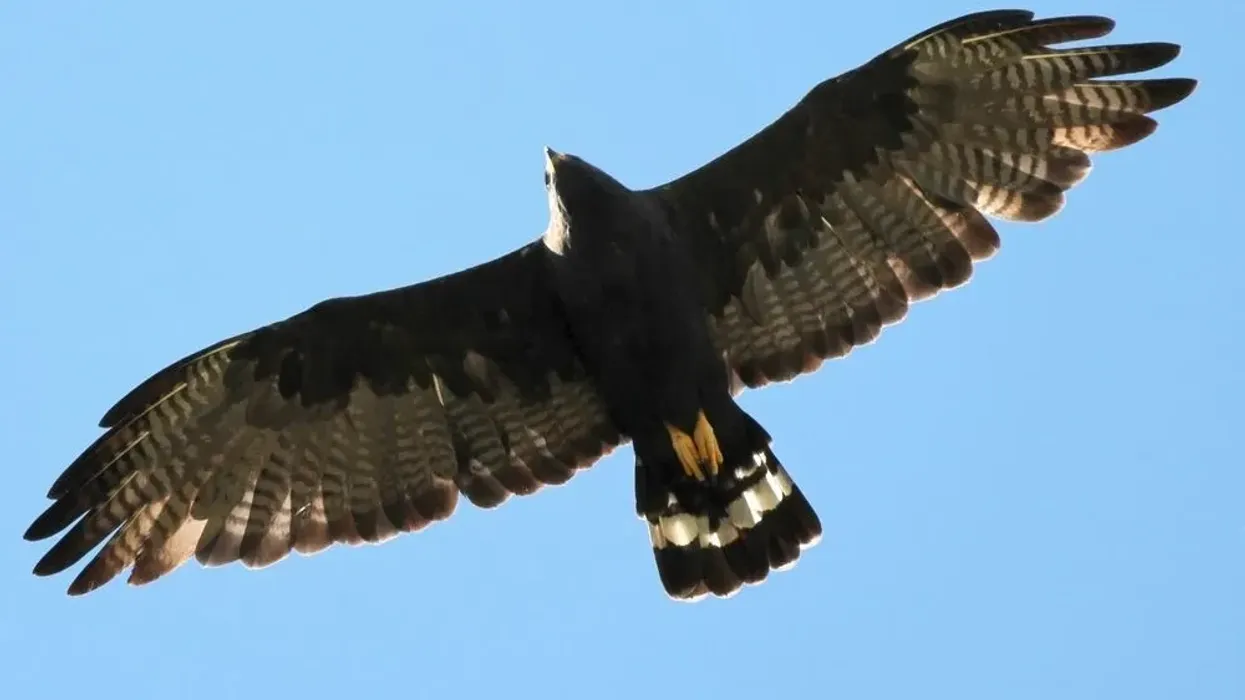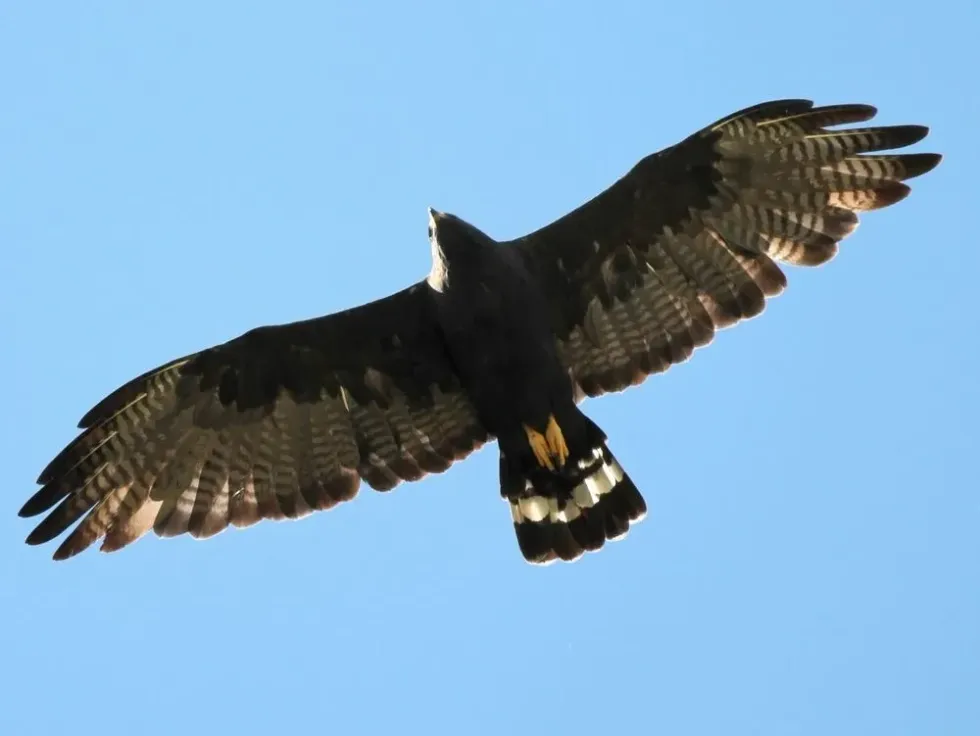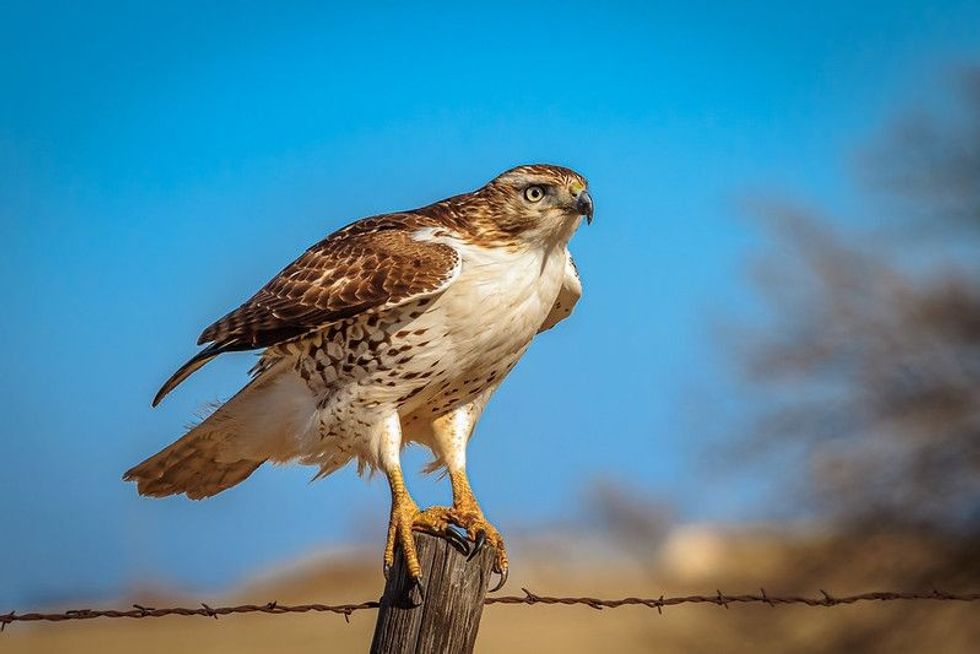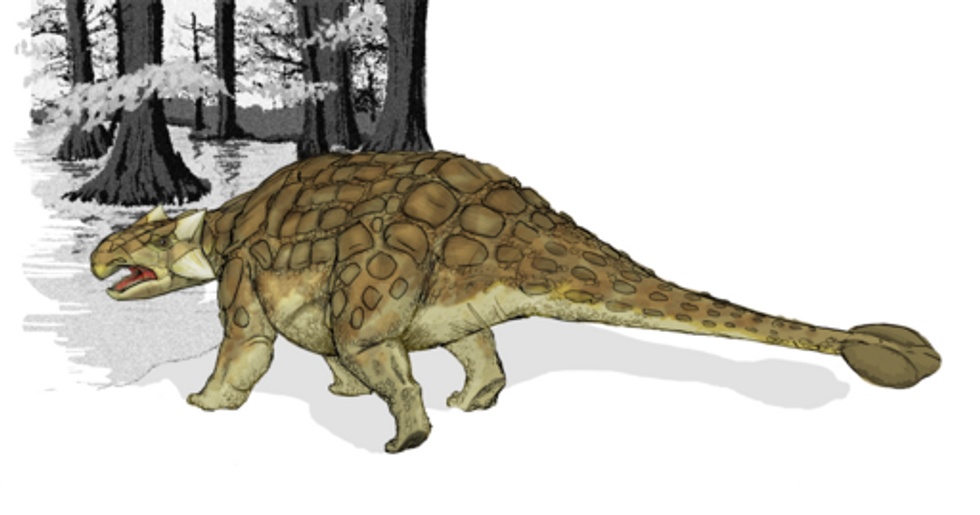The zone-tailed hawk is a large but slender Buteo hawk, resembling a Turkey vulture. The zone-tails are comparable in length and wingspan to the red-tailed hawk. The adult feathers are mostly blackish.
The striking exception is that the flight feathers are suspended with lighter gray, which can appear thick silver-gray from a distance. Adults resemble the common black hawk but are leaner in flight and small, and they have more white stripes on the tail. In addition to that, the tail pattern is also the same as Turkey vulture.
If you like this, then also check interesting facts of Cooper's Hawks or Hawk facts.
Zone-Tailed Hawk Interesting Facts
What type of animal is a zone-tailed hawk?
Zone-tailed hawk buteo belongs to a family of birds. It is somewhat similar to turkey vulture and may even use this characteristic to its advantage by flying and blending into groups of turkey vultures.
What class of animal does a zone-tailed hawk belong to?
These bird species (Buteo albonotatus) come from a bird kin (Aves) looking similar to turkey vulture.
How many zone-tailed hawks are there in the world?
Since the population of zone-tailed hawk buteo species is increasing rapidly, especially its range growing in the United States, it is estimated up to two million.
Where does a zone-tailed hawk live?
They usually reside in coniferous or pine-oak forests as well as on timbered canyons, hilly riverine woods, dry open boscage, humid forests, and excessive marshes. They range from parts of southern Arizona, New Mexico, and western Texas. They are also found in the central portions of Central America, South America, Ecuador, Peru, Southern Brazil, and northern Argentina.
What is a zone-tailed hawk's habitat?
Zone-tailed hawks are large birds of the riparian zone that thrives on mountains and arid hills of the Southwest canyons. These raptors live in large trees along creeks, in cactus, open desert, and sometimes on canyon walls.
Who do zone-tailed hawks live with?
Since Turkish vultures are seen flying in groups, zone tails also mingle with them in groups and are often missed by birding people.
How long does a zone-tailed hawk live?
They can live up to 25 years depending upon the food and surrounding.
How do they reproduce?
The bird species (Buetos albanatos) mating season differs geographically but is almost always in the first half of the year. In the northern areas, the breeding season is mid-April through July, whereas in Ecuador, it is February through June.
Eggs have been seen as late as August in Colombia.
The mating pair performs a-wooing display, which includes interlocking in aerial loops, dives, and rolls with each other. The nest is typical of hawks: a significant, bulky collection of sticks lined with green leaves, usually built in the top of the main branch of a tree.
The eggs are around one to three, and they are typically white, often marked with brown. Incubation lasts for around 28- 35 days. Usually, the female bird incubates, and the male bird is feeding the female during that period. The male may also set the eggs.
What is their conservation status?
Least Concern as their population is increasing rapidly in various regions. These zone tails hawks are only vulnerable if their nesting sites are disturbed. Also, they are not considered threatened or endangered except in Texas, as the population there is decreasing due to the loss of habitat.
Zone-Tailed Hawk Fun Facts
What do zone-tailed hawks look like?
The zone-tailed hawk is a slender body with blackish-grey color found in the U.S. Their feet are yellow with a tearing beak to eat flesh. These birds have an interesting tail pattern in comparison to turkey vultures and have a small gray area in front of the eyes.
They take a flight with their wings slightly raised and seldom move back and forth.
How cute are they?
They look cute and are adorable feathery birds species. However, being a raptor, tailed hawk Buteo albonotatus are generally not hostile to humans but can attack surprisingly from behind if it feels threatened or scared. Their similarity to vultures can often confuse humans while spotting one.
How do they communicate?
Zone-tailed hawk raptors uses various calls, depending on the condition. An alarm call is a harsh “kreeeee”, if a predator advances near the nest.
When adults are soaring or hunting, they sent out a harsh “kreeeeearrr”. Male can also utter sounds during courting and before mating. When the female is incubating, she announces a rapid “E-gip” when the male approaches to give her and the family food.
Noisy, prompt call “kip-kip-kip-kip” may be given by both adults in response to each other during the breeding and nesting stage. The most usual one is “kreeeee”, given by adults and young when upset. The young hawks beg for food with sad, high-pitched “kreeep”. When young receive their prey, they utter a sharp “weee-uk”.
How big is a zone-tailed hawk?
Zone-tailed hawks weigh around 1.34-2.07 lb (610–940 g) and around 17.7-22 in (45-56 cm) in height.
How fast can a zone-tailed hawk fly?
The speed of these raptors depends upon their food. They fly slowly over treetops by positioning their flight feathers in V-shape.
Once they spot the prey, they dive from low heights, thus changing their wing pattern to a narrow shape. Usually, they are seen copying the Turkey vultures flight style while moving in the sky. Apart from that, they perform soaring flights with few slow wing beats and also display the beating of wings rapidly while hunting.
How much does a zone-tailed hawk weigh?
They are medium-sized birds larger than red-shouldered hawks and smaller than red-tailed hawks. Their weight is around 1.8 lb (180 g), and the wingspan is about 29.9-30.9 in (78-78.6 cm).
What are the male and female names of the species?
There is no specific name given to male and female hawk species. They are referred to as male and female only like most other animals.
What would you call a baby zone-tailed hawk?
As is common in raptor birds, the older sibling oftentimes kills the younger one or outcompetes it for food. In rare cases, both make it up to adulthood. The younger one is sometimes referred to as the "spare" one because the first one dies, and the remaining one is favored.
What do they eat?
Zone-tailed hawks eat birds, mammals, reptiles, and amphibians. They are even spotted eating fish.
To hunt such varieties of prey, they have devised several strategies. Their prime trick is to fly slowly and rather low (similar flight style of vultures) over uneven terrain resembling a turkey vulture, then falling suddenly onto a lizard, small mammal, or ground-dwelling bird.
In fewer scenarios, they may be seen chasing and relishing birds on the flight. These tailed hawk, Buteo albonotatus, species are known to be solitary and prefer hunting alone and not as a pair.
They use trees and other scene features as covers when approaching prey to hide until just before striking. In boulder-strewn habitats, they prey heavily on large lizards, especially common collared lizards and crevice spiny lizards.
They also feed on animals such as ground squirrels, antelope squirrels, rock squirrels, chipmunks, and rabbits.
Scaled, Montezuma, California, and Gamble's Quail, woodpeckers (Acorn Woodpecker, Northern Flicker), nightjars (Common Nighthawk, Common Poorwill), jays (Wood house's Scrub-Jay, Steller’s Jay), thrushes (American Robin, Western Bluebird), and other passerines including Cassin’s Kingbird, Red Crossbill, Western Meadowlark, and Rufous-crowned Sparrow are common food. The diet in tropical regions is even more diverse.
Are they dangerous?
Yes, zone-tailed hawks are dangerous when disturbed during breeding and act aggressively while protecting their nests.
Would they make a good pet?
Zone-tailed hawks are aggressive species when it comes to defending their nests and during breeding. They are wild raptor birds who prefer to thrive in the wilderness and fly.
When they are held captive as a pet, it restricts their innate capabilities and true nature and also may affect their diet. So, it's preferable to let them be free in the open. Also, many places have declared it illegal to have hawk species as their pet, and others have been permitted to keep them under confined laws.
Did you know...
The zone-tailed hawk buteo has the prowess to defend its territory and nests by aggressively attacking red-tailed hawks, golden eagles, bald eagles, and humans.
There is a close resemblance of zone-tail birds to Turkey vultures, and this raptor often mimics and uses its similarity to hunt prey.
Encouraging hawks is the gold model of backyard birding. A friendly backyard environment can actually invite a hawk.
Do zone-tailed hawks migrate?
Yes, they are migratory birds and these hawks (Buteo albonotatus) migrate during the spring and summer seasons as they are intolerant of winter weather.
How many eggs do zone-tailed hawks lay?
Female zone-tailed hawks lay one to three eggs per clutch. In southwestern regions of the United States, the breeding takes place only once a year.
The young hawks are born immature, so they need special care and assistance from the adults. Also, after hatching, they grow slowly for the first seven days, then faster from 7-21 days. They fledge at 40-55 days, though they are not entirely ready until around a week later.
Here at Kidadl, we have carefully created lots of interesting family-friendly animal facts for everyone to discover! For more relatable content, check out these birds of paradise facts and Frigate bird facts pages.
You can even occupy yourself at home by coloring in one of our free printable golden eagle coloring pages.
Second image by cricketsblog.










